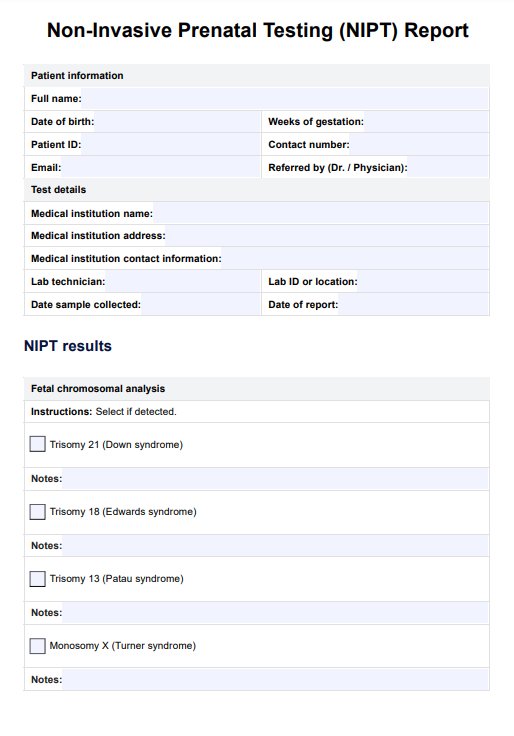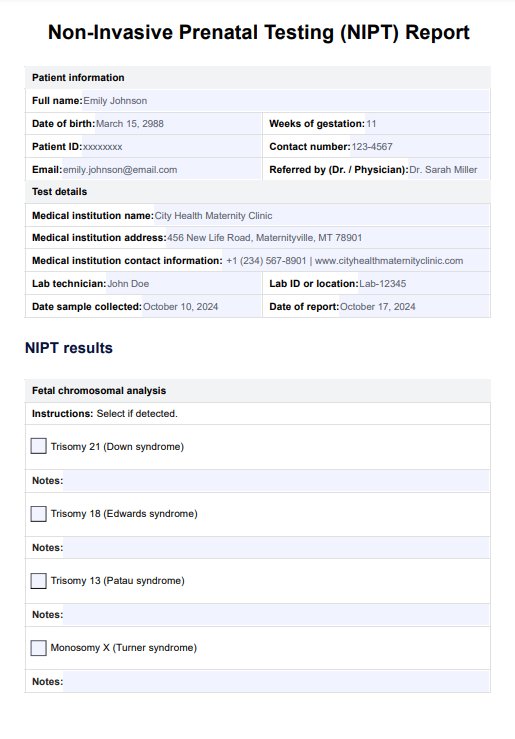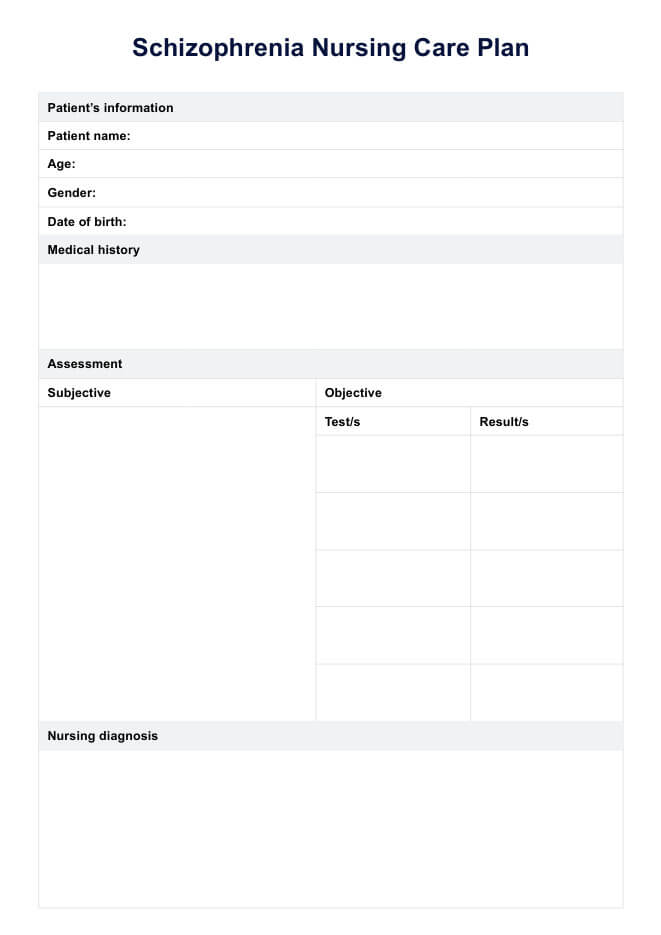NIPT Blood Test
Discover accurate prenatal screening with our NIPT Test. Get reliable results for genetic conditions early in pregnancy. Download our free PDF guide now.


What is an NIPT Test?
Noninvasive Prenatal Testing (NIPT), also called noninvasive prenatal screening or cell-free DNA screening, is a cutting-edge procedure that assesses the risk of certain genetic conditions in an unborn child. Unlike traditional prenatal tests, NIPT requires only a blood sample from the pregnant person, significantly reducing the risk of miscarriage associated with invasive procedures like amniocentesis.
The test analyzes the DNA fragments from the placenta that circulate in the pregnant person's blood. These fragments carry genetic information about the fetus, which can be examined for abnormalities. NIPT is highly sensitive and can detect conditions such as trisomy 21 (Down syndrome), trisomy 18 (Edwards syndrome), and trisomy 13 (Patau syndrome) with remarkable accuracy. Additionally, it can determine the baby’s sex and Rh factor, which can be crucial for managing Rh incompatibility conditions.
NIPT is recommended as an option for all pregnant women. Still, it is particularly valuable for those with increased risk factors, such as advanced maternal age, a family history of genetic disorders, or abnormal findings on an ultrasound or previous screening tests. It is typically offered from the 10th week of pregnancy onwards.
The simplicity and non-invasive nature of the test, combined with its high accuracy, make NIPT a preferred choice for early genetic screening. It provides expectant parents with important information without posing significant risks to the mother or the fetus. As research and technology advance, the scope of NIPT continues to expand, allowing for the detection of additional genetic conditions and further contributing to comprehensive prenatal care.
NIPT Blood Test Template
NIPT Blood Test Example
How does the NIPT Blood Test work?
The NIPT Blood Test process is a streamlined and straightforward procedure that involves the following steps:
Step 1: Blood sample collection
The process begins with collecting a blood sample from the mother's arm, similar to a routine blood test. This sample contains maternal and fetal DNA, which circulates freely in the mother's bloodstream.
Step 2: DNA analysis
The collected blood is then sent to a specialized laboratory. Here, scientists isolate the cell-free DNA (cfDNA) and utilize advanced genomic sequencing technologies to analyze the fetal DNA fragments for any chromosomal abnormalities.
Step 3: Advanced bioinformatics assessment
Using sophisticated bioinformatics tools, the data is carefully assessed to differentiate between maternal and fetal DNA and to detect any excess or deficiency in the fetal chromosomes that could indicate a genetic disorder.
Step 4: Result recording and interpretation
A medical professional records the results in the template provided in the guide, interprets them, and writes them in the guide as well. The report typically shows the risk levels for specific chromosomal conditions. The results are not diagnostic but provide a risk assessment that can indicate whether further diagnostic testing is recommended.
Step 5: Follow-up
If the NIPT results suggest a high risk of a genetic condition, the healthcare provider may recommend additional diagnostic tests, such as amniocentesis or chorionic villus sampling (CVS), to confirm the findings.
When would you use the NIPT Blood Test template?
The NIPT template is a pivotal resource in prenatal care, utilized under various circumstances to enhance the understanding of fetal health. It is particularly used by healthcare providers who are conducting the test because of the following conditions or situations:
- Advanced maternal age: Women over the age of 35 at the time of delivery who have an increased risk of chromosomal abnormalities.
- Abnormal ultrasound findings: If an ultrasound reveals conditions that may suggest chromosomal disorders, NIPT offers additional insights without the risks of invasive testing.
- History of chromosomal abnormalities: Families with a history of genetic conditions can benefit from early detection through NIPT.
- Positive results from other screenings: Should initial screenings indicate potential risks, NIPT is a subsequent, non-invasive step for further clarification.
- Informed decision-making: For parents seeking early information about the genetic health of their baby to make informed decisions about their pregnancy.
- Rh factor determination: When it’s necessary to determine the baby’s Rh factor for managing Rh incompatibility.
NIPT is not a diagnostic test but a screening tool that provides risk assessment for certain genetic conditions. It serves as a guide to appropriately applying this screening test, ensuring it is integrated into patient care when most beneficial.
What do the NIPT test results mean?
NIPT outcomes are typically categorized as ‘low risk’ or ‘high risk’ for certain genetic conditions. Here’s what these results generally signify:
- Low risk: This indicates that the likelihood of the fetus having the screened conditions, such as trisomy 21 (Down syndrome), trisomy 18 (Edwards syndrome), or trisomy 13 (Patau syndrome), is minimal. However, it’s important to note that a low-risk result doesn’t guarantee the absence of these conditions; it merely suggests that they are unlikely.
- High risk: The positive predictive value of a high-risk result indicates that there's a significant change that the fetus may have one of the conditions being screened for. This does not confirm the condition is present but indicates a need for further diagnostic testing, such as amniocentesis or CVS, to make a definitive diagnosis.
- Sex chromosome information: If opted for, NIPT can also reveal the sex of the fetus and the presence of any abnormalities in the sex chromosomes, like Monosomy X or Klinefelter syndrome.
- No result: Occasionally, an NIPT may not be able to provide a clear result, which could be due to insufficient fetal DNA in the blood sample or other technical reasons. A repeat test or alternative screening methods may be recommended in such cases.
Despite these results, do also note that results may be false positive and false negative.
Research & evidence
NIPT represents a transformative leap in prenatal screening. Its inception dates back to the discovery of cell-free fetal DNA (cffDNA) in maternal plasma in 1997, which provided a new avenue for genetic testing that did not pose a risk to the fetus (Lo et al., 1997). Since then, NIPT has undergone extensive clinical research and validation, leading to its adoption as a routine screening tool in many countries.
The efficacy of NIPT in detecting trisomy 21 (Down syndrome), trisomy 18 (Edwards syndrome), and trisomy 13 (Patau syndrome) has been well-documented. In a 2015 study, Gil et al. found that NIPT has a 98.6% sensitivity for Edwards syndrome. NIPT also has a high sensitivity for trisomy 18 (98.2%) and trisomy 13 (99%), according to Norton et al. (2015). NIPT also has been found to significantly reduce the number of invasive diagnostic procedures, such as amniocentesis, which carry a risk of miscarriage.
The American College of Obstetricians and Gynecologists (ACOG) now recommends that NIPT be offered to all pregnant women, regardless of age or risk factors, as an option for first-line screening (American College of Obstetricians and Gynecologists’ Committee on Practice Bulletins—Obstetrics, & Committee on Genetics, Society for Maternal-Fetal Medicine, 2020).
As NIPT technology continues to evolve, ongoing research is focused on improving its accuracy, expanding the range of detectable conditions, and making it accessible to a broader population.
References
American College of Obstetricians and Gynecologists’ Committee on Practice Bulletins—Obstetrics, & Committee on Genetics, Society for Maternal-Fetal Medicine. (2020). Screening for fetal chromosomal abnormalities. Obstetrics & Gynecology, 136(4), e48–e69. https://doi.org/10.1097/aog.0000000000004084
Gil, M. M., Quezada, M. S., Revello, R., Akolekar, R., & Nicolaides, K. H. (2015). Analysis of cell‐free DNA in maternal blood in screening for fetal aneuploidies: updated meta‐analysis. Ultrasound in Obstetrics and Gynecology, 45(3), 249–266. https://doi.org/10.1002/uog.14791
Lo, Y. M. D., Corbetta, N., Chamberlain, P. F., Rai, V., Sargent, I. L., Redman, C. W., & Wainscoat, J. S. (1997). Presence of fetal DNA in maternal plasma and serum. The Lancet, 350(9076), 485–487. https://doi.org/10.1016/s0140-6736(97)02174-0
Norton, M. E., Jacobsson, B., Swamy, G. K., Laurent, L. C., Ranzini, A. C., Brar, H., Tomlinson, M. W., Pereira, L., Spitz, J. L., Hollemon, D., Cuckle, H., Musci, T. J., & Wapner, R. J. (2015). Cell-free DNA analysis for noninvasive examination of trisomy. New England Journal of Medicine, 372(17), 1589–1597. https://doi.org/10.1056/nejmoa1407349
Commonly asked questions
Pregnant women, often those over 35 or with a family history of genetic conditions by maternal fetal medicine specialists.
Usually between the 10th and 13th week of pregnancy.
As a screening tool to assess the risk of chromosomal abnormalities.
The blood draw takes a few minutes, with results typically available within one to two weeks.

.jpg)














































































































